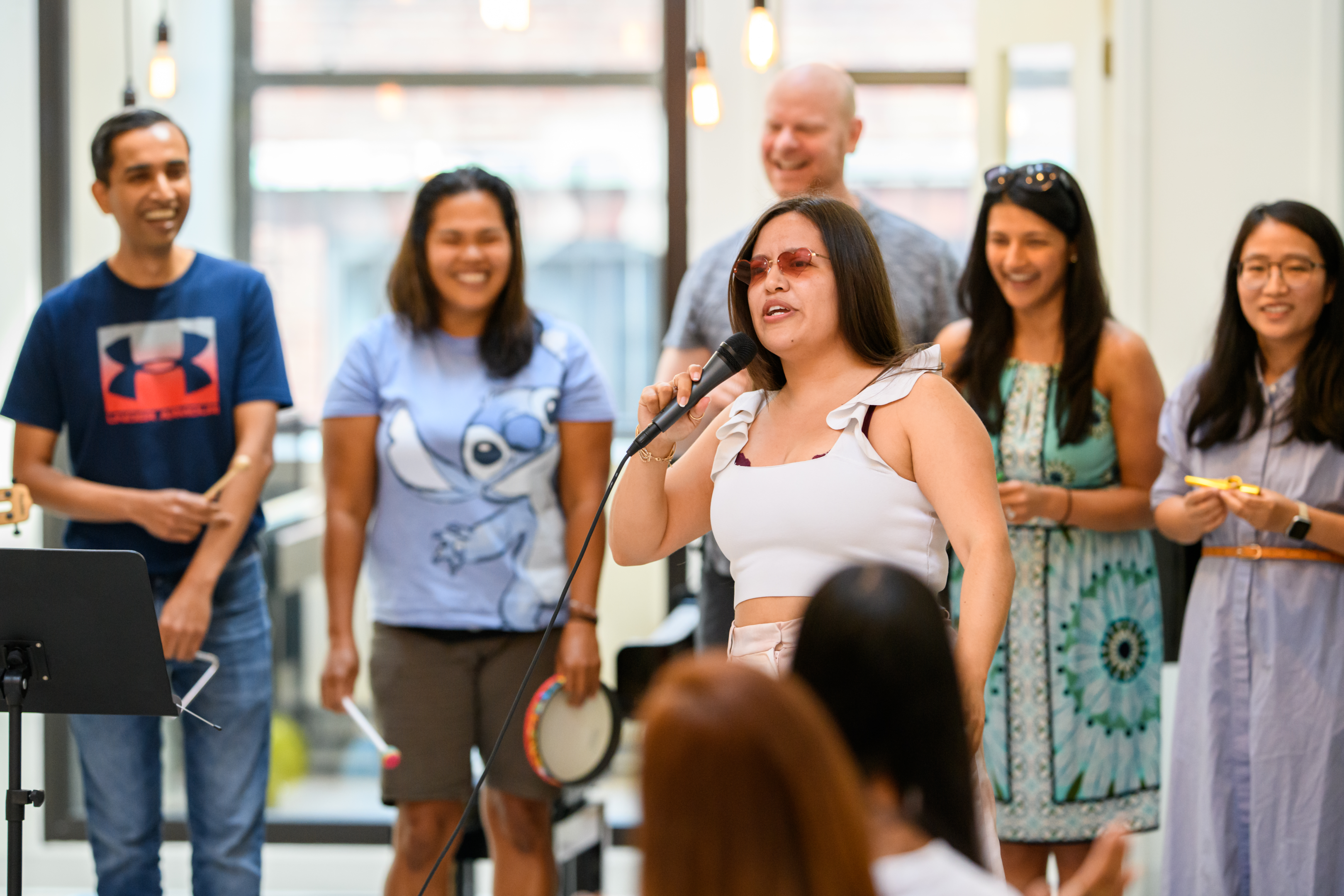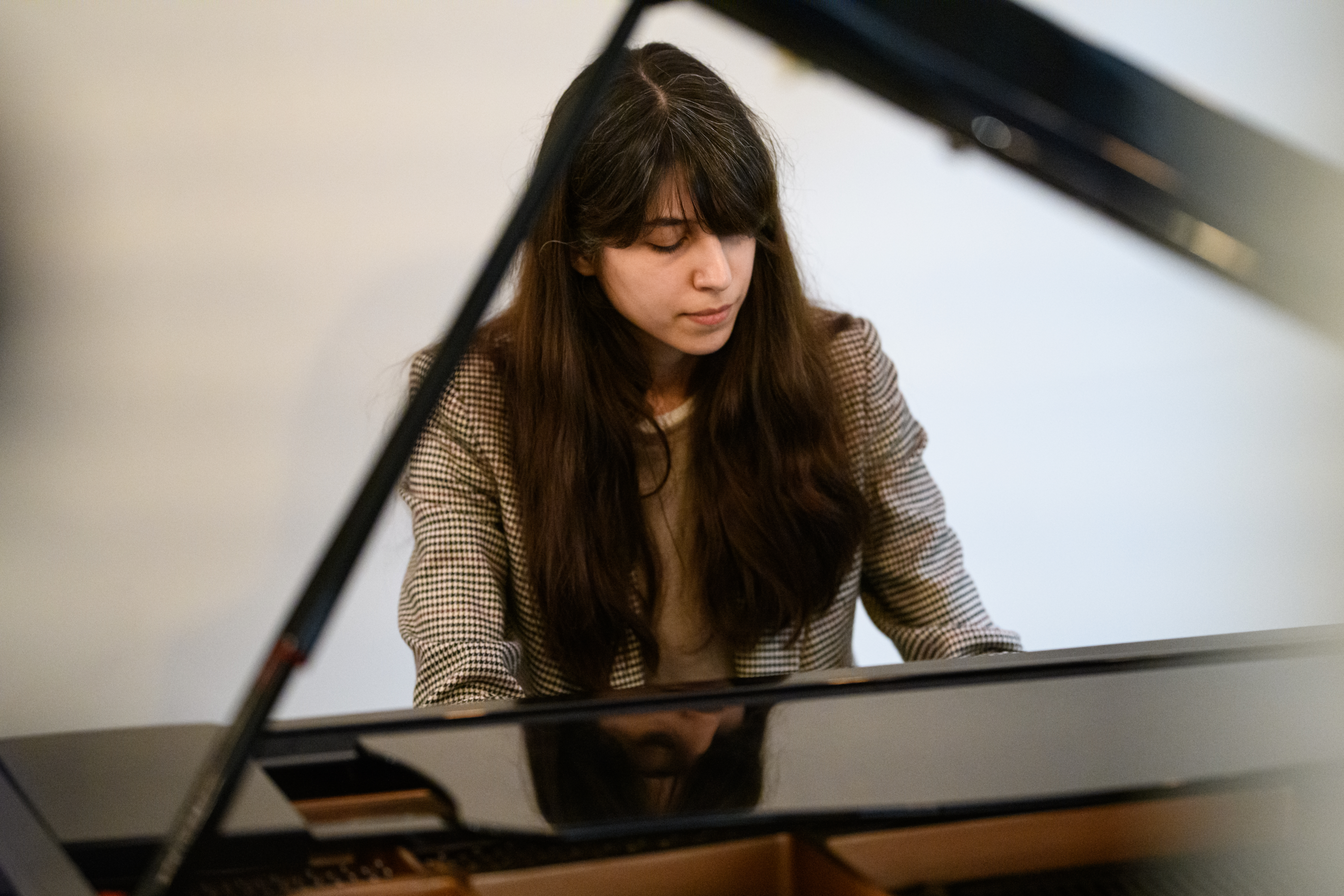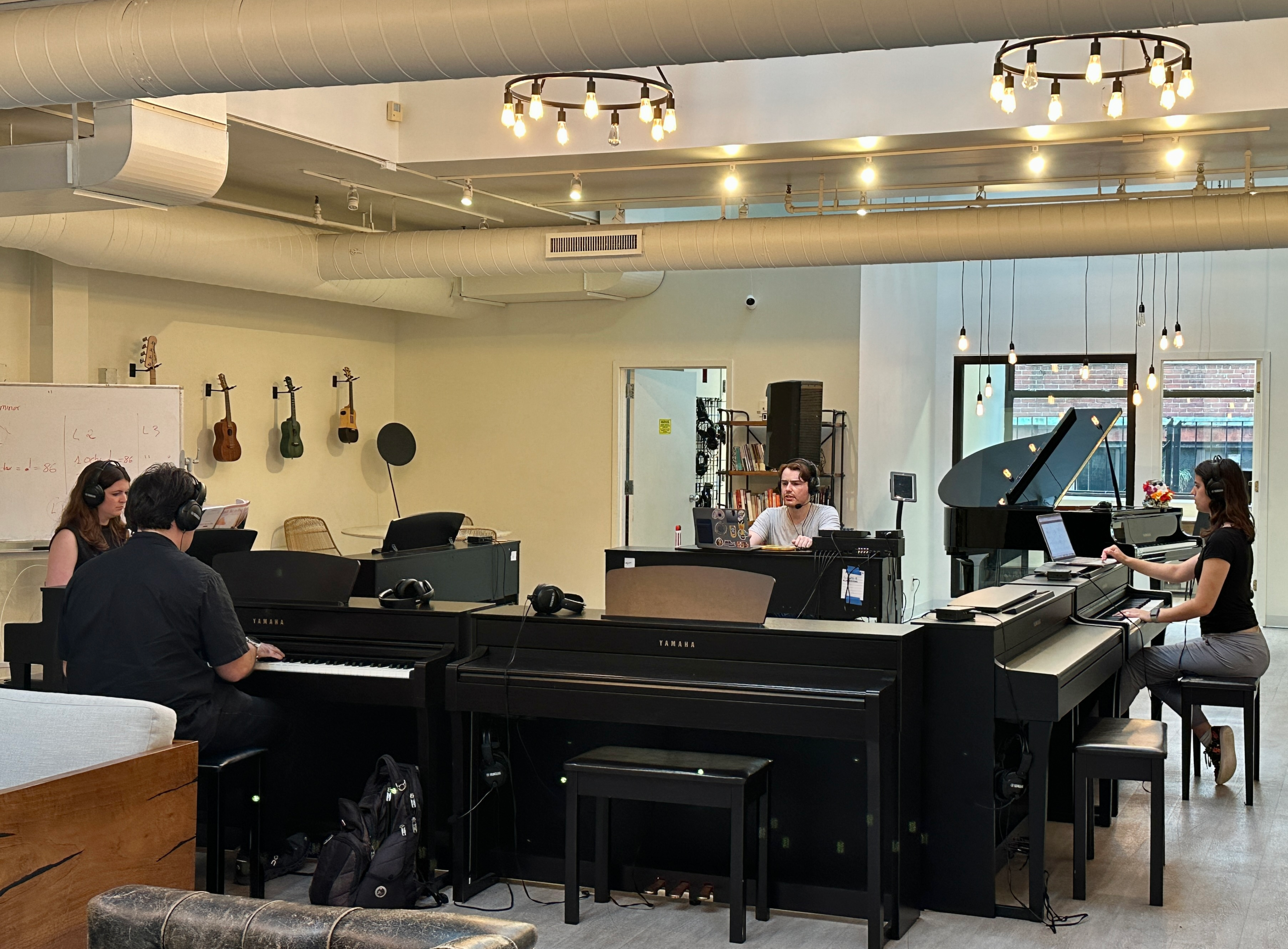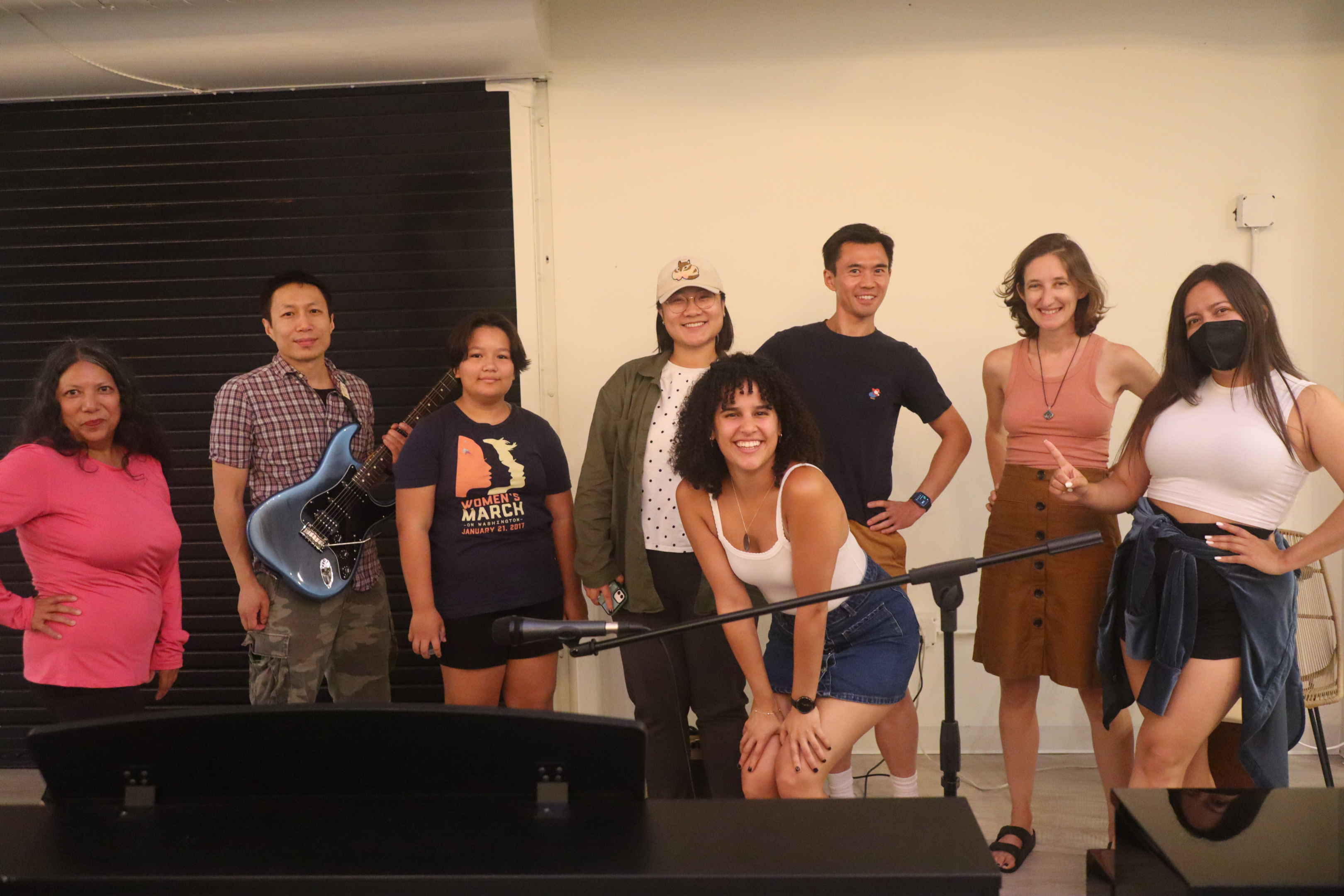Blog
Accelerate Your Music Skills: Harness the Power of Motor Learning

So, you’ve just had a major breakthrough in one of your music lessons, and you’re really excited about it! But by the time your next lesson rolls around, you’ve forgotten most of your learning. Why?
This is because singing and playing instruments are motor skills, and the science of motor learning has taught us that if new skills aren’t reinforced through repetition, the human brain forgets them within three days. If you only do weekly lessons, you’re missing out on a LOT of progress, so what can you do?
In this series of blogs, we’ll explore the science of motor learning and give practical tips on how to harness its principles to benefit both children and adult learners in their development: Whether you’re a beginner musician looking to make rapid progress in your first 30 days, a long time student seeking to maximize your practice benefits outside the studio, or if you have a busy schedule and are looking to optimize the hours your do have for learning music – This blog is for you.
By understanding the world of motor learning, you’ll be able to do all these things and more. So let’s dive into it!
What Is Motor Learning?
Motor learning is the process of acquiring and refining motor skills through repetition. Unlike learning other academic subjects, motor learning involves developing coordination, dexterity, and muscle memory to the performance level you’re looking for (for instance, a vocalist looking to sing on key). In short – development of the brain-body connection. When learning to make music, the stronger this connection is, the easier it is to learn and the faster we see results.
Engaging in different motor learning techniques allows you to develop your fine motor skills faster and more efficiently while developing problem-solving skills when troubleshooting your mistakes, and enhancing your creativity.

The 3 Stages Of Motor Learning
Motor learning consists of three distinct stages – the Cognitive Stage, Associative Stage, and Autonomous Stage. Our focus during each stage is different, so the way we train our motor skills during each stage has to also be different. Knowing this concept benefits music students by building their self-awareness, and aids their teacher in designing the instruction and training programs that will be specified to their students and their goals.
The Cognitive Stage
The beginning phase: Here, we’re trying to grasp the basic mechanics that are needed to perform the skill. Learners in this stage rely heavily on conscious thought, simple instruction, and support from their teacher. For instance, if you’re a voice student trying to sing the correct pitches, it might take a lot of effort on your part to recognize the notes you’re hearing and to replicate them. Pianists may work on coordinating both hands, while guitarists learn to transition smoothly between chord positions while not falling out of the rhythm of the piece.
At this point, successful performance of the skills can be a hit or miss, and it’s very common to make mistakes as you figure out the precise movements required. Learners will need deliberate practice and plenty of support to get the hang of it, which requires them to put in the hours outside of their lessons.
The Associative Stage
This stage is about upping your game – improving your technique, cutting down on errors, and getting more consistent in your playing. Here is where you will see the biggest development.
As you go over the skills again and again, you will start recognizing patterns and you’ll develop problem-solving skills for correcting your mistakes. For instance, the singer learning to sing the right notes had to concentrate really hard in the cognitive stage, but at this stage, they are starting to recognize melodic patterns or repeating notes, and they remember how it feels in their body to perform them.
This newfound awareness allows you to become more sensitive to the nuances of the music, and you’re able to perform the skills more consistently and confidently.
The Autonomous Stage
This is the final stage: Here, the skill you’re working on will start to feel automatic.
After hours of repetition, you’ll have refined your abilities and developed the muscle memory required to perform the skill habitually and with little to no conscious effort. You’ll find you’re able to perform it under different musical contexts and situations and you’ll feel like a natural! For instance, at this stage, our singer from the examples above will be able to hear and repeat melodies or phrases correctly without thinking or they’ll sense the key of a song just by listening to the accompaniment.
Of course, everyone’s journey is unique, and it’s important to note that the progression through these stages may vary from person to person and depend on many factors; such as the individual’s skill level, the number of hours spent refining the movements, how easy or difficult the skill is, and more.
The Principles Of Learning Fine Motor Skills

Now that we know what motor learning is, how do we apply it to our learning? This is done with the use of motor learning principles.
Motor learning has principles that are derived from research and observations on how individuals acquire and improve their motor skills. They exist as guidelines on how to learn efficiently, and research has shown that by taking advantage of them in our training, our retention, and development of skills are enhanced.
Here are some of the training principles you can use to optimize your learning. You may choose to try one or the other depending on your learning goals, current level, frequency of your music lessons, and other factors:
Variability: This principle emphasizes the importance of practicing motor skills in various contexts and conditions because working heavily only on one skill creates an imbalance. If you’re a pianist, that could mean trying the song at different tempos, in various environments, or even experimenting with different body positions. This variability helps you become a more adaptable and versatile musician, ready to perform in real-life situations, like a piano performance or audition.
Distributed Practice: This means breaking the training into short, spaced-out, targeted practice sessions rather than practicing for an extended period in one sitting. Research suggests that this allows the student to have as much repetition as possible on the movements without getting overworked or fatigued – helping them retain new abilities better.
You could try spending no more than 15 minutes per session on the difficult passages of your song, but doing so a few times a week or even several times a day. Taking advantage of our instrument labs, group classes, and open practice time is a great way to implement this principle in your routine.Periodic Evaluation: It is essential that you get time comments from your teachers with constructive suggestions for improvement. You’ll better understand the correctness of your movements, identify mistakes, and make necessary adjustments. It is essential for observations to be specific, informative, and not critical or overwhelming to facilitate effective learning. Using the Musicians Playground group classes as a guided review time with an instructor is a good way to get additional support!
Visualization: Visualization involves mentally rehearsing motor skills without physically performing them. Research suggests that incorporating visualization to supplement physical practice can enhance retention and correct execution. It helps strengthen neural pathways, refines movement patterns, and can be particularly useful during periods when physical practicing is limited.
Whole Practice vs. Part Practice: This strategy deals with how complex movements are broken down and practiced. In whole practice, the entire piece is practiced as a whole, while in part practice, it is isolated into smaller parts.
Choosing between the two depends on the nature of the movement: Simple skills can be better learned through Whole Practice, while complex skills may benefit from Part Practice, allowing you to focus on mastering individual parts before putting them together. Vocalists who are singing through a difficult passage of a song, for instance, will benefit from isolating it and working on the hard parts individually – this will reduce fatigue and make the training more specific.Blocked Practice: In this approach, we focus on a single movement or a specific part of a piece, repeating it over and over during a practice session. This will lead to fast results, but it may result in a limited ability to transfer the skills to different contexts or situations. If you’re working on a song where most of it goes smoothly, but there’s one bar or phrase that we consistently struggle with, this principle could be useful to you. Dedicating a whole session to working through that one kink might be the most efficient way to perfect your performance.
As you can see, the principles of motor learning provide many benefits to our music journey:
Efficiency: Following the principles of motor learning will allow you to progress more efficiently and effectively. The music learning journey becomes less time-consuming and more focused because you’re working towards one goal at a time rather than trying to master a wide range of movements all at once.
Retention: Applying these principles promotes better retention of the learned skills because they ensure you get enough repetition on them.
Transferability: Motor learning principles help learners develop skills that can be transferred to different contexts. For example, by understanding the relationship between chords, guitar players will be able to transpose songs quickly or use the same chord shape in different keys.
Optimized Feedback: Providing appropriate support and timely assessment is crucial for improvement. Asking your teachers for specific and helpful comments on your progress will help you understand what you’re doing well and where you can improve without making you feel stuck.
Individualization: Research on these principles recognizes that learners have unique abilities, learning styles, and developmental stages. By tailoring the training to the individual, motor learning principles can enhance the music learning experience and accommodate different levels.

Practical Application To Enhance Your Music Learning
A musician can apply the principles of motor learning to their training in order to fast-track their results. Let’s take one of the fundamental skills needed when learning music – reading sheet music – and explore how it applies when learning a new song, using our newfound knowledge of motor learning:
Variability: You can introduce variability into your training by going over the same piece of sheet music in different ways. For example, you can play it at different speeds, isolate the right or left hands, perform it with an accompaniment or by yourself. This will help you play through the piece will less conscious thought, as you’ll have other things to think of.
Distributed Practice: Instead of practicing a piece of music for hours in one sitting, you can break the training sessions into shorter, spaced intervals throughout the day, or a few times a week. For example, you can rehearse for 10 minutes in the morning, 10 minutes in the afternoon, and 10 minutes in the evening. This approach allows for better retention and prevents mental and physical fatigue.
Periodic Evaluation: You can seek support from a teacher in one of the group lessons, or by recording yourself while reading from the sheet music. This can help you identify areas for improvement, such as accuracy, timing, or expression. Having specific and constructive feedback is essential for developing problem-solving skills and allows you to make adjustments and troubleshoot your errors.
Mental Practice (Visualization): Before you physically play the song from the sheet music, you can mentally practice it. Visualize yourself reading each note, counting the rhythms, and feeling the dynamics. Mental rehearsal really aids in the development of your musical memory.
Whole Practice vs. Part Practice: When learning a complex piece from sheet music, you can use Part Practice to isolate the challenging sections, instead of spending hours reviewing the parts you already know for maximum efficiency. For instance, you can isolate a passage of two to four bars and play it slowly and carefully until it becomes more manageable, gradually speeding up as you get more comfortable. Once you have mastered all of the individual parts, you can integrate them into the whole piece by using Whole Practice.
Blocked vs. Distributed Practice: When learning to play a new piece from sheet music, you can start with blocked practice. Repeat the piece several times, focusing on getting the pitches and rhythm correct. As you become more familiar with the piece, you can switch to distributed practice, alternating between practicing different sections of the piece or even reviewing other pieces in your repertoire. This approach reinforces your memory and promotes creativity and well-rounded musicianship.
By applying these principles to different skills you learn, you can fast track your development when learning music: Strategically planning a deliberate practice schedule that has specific, attainable goals will ensure you’re focusing your efforts and valuable musical training time on the right things.
Elevate Your Experience In Your Music Lessons

As we said, music education is not like learning other academic subjects – it requires creativity, problem-solving, a strong awareness of your body, effort, and many hours spent working on your coordination and refining your skills. Trust us when we say – your body wants you to do well!
We used the example of learning to play from sheet music in order to illustrate the many benefits of using the principles of motor learning in your practicing, but these can be applied anywhere: Pick a technique you’ve been stuck on for a while, and think about how you can integrate some of these principles into your current practice.
If you need additional support, consult your instructor here at Musicians Playground: They will tailor their teaching to your needs and provide you with tips and materials to guide your development.
We really hope this article opened your mind to the world of motor learning and showcased its many advantages in music education. If you enjoyed this article, stay tuned for the next installments in our blog, which we will dedicate to taking you through the mechanical and technical requirements for each instrument, and explaining how you can use the principles outlined here to elevate your music learning journey! To stay updated on those, consider signing up to our mailing list.
Finally, if you think you’re ready to start making music, we’d love to have you here at MP – Boston’s number 1 club for music lovers! Book a call with one of our membership advisors, and we’ll get you started. In the meantime – happy learning!

